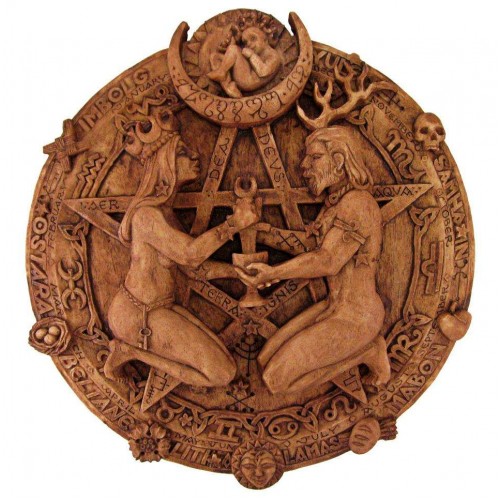
Wicca, a modern pagan religion rooted in ancient practices, celebrates the sacred duality of gender as a cornerstone of its philosophy, rituals, and worldview. At its heart, Wicca honors the interplay between femininity and masculinity, represented as the Goddess and the God, two complementary forces that embody the natural rhythms of life and the cosmos. This duality is not merely a structural framework but an encompassing theme that pervades every aspect of Wiccan practice, from seasonal festivals to personal spirituality. Through its rituals and teachings, Wicca underscores the synonymous relationships between femininity and the female, masculinity and the male, while emphasizing the balance and harmony between these forces as central to understanding existence.
The Duality of the Divine: The Goddess and the God
Wicca venerates a dual deity system that symbolizes the interplay between feminine and masculine energies. The Goddess, often associated with the Moon, Earth, and fertility, represents femininity, nurturing, and creation. She is the embodiment of the female principle, synonymous with life-giving and sustaining forces. This is why the uterus and often vagina too are ubiquitous symbols of the feminine. Conversely, the God, connected to the Sun, wild nature, and the hunt, embodies masculinity, protection, and transformation. And just as with his feminine counterpart, the phallus is the symbol of masculinity. Together, these deities reflect the duality and balance necessary for the functioning of the universe.

This sacred duality is integral to Wiccan cosmology, where the Goddess and the God are seen as interdependent, each providing meaning and purpose to the other. Their union is celebrated in rituals such as the Great Rite, a symbolic act of creation and unity that underscores the importance of their harmonious relationship. These divine archetypes are not static but evolve throughout the year, embodying the cycles of nature. The Goddess transitions from Maiden to Mother to Crone, reflecting the phases of the Moon and the stages of life, while the God moves through birth, death, and rebirth, mirroring the Sun's journey across the seasons. This cyclical dance is a profound expression of how femininity and masculinity shape the natural world. But one thing they do not do is shift gender or change sex. They remain representative of their sexes just as the universe has remained constant.
The Role of Gender in Wiccan Rituals
Wiccan rituals are steeped in the celebration of gender and its symbolic interplay. The Sabbats, which mark the Wheel of the Year, are deeply connected to the relationship between the Goddess and the God. For instance, Beltane honors their union as the land bursts into fertility, while Yule celebrates the rebirth of the Sun God through the Goddess’s nurturing power. These rituals highlight how the interplay between femininity and masculinity fosters growth, renewal, and balance in the natural world.
Tools and symbols used in Wiccan ceremonies further emphasize gender duality. The athame, a ritual knife representing the God, is a symbol of the phallus and is often paired with the chalice, representing the Goddess and the vagina. The union of these tools in rituals signifies the sacred marriage of male and female energies, a metaphysical act of creation and harmony. These symbolic acts serve as a reminder of the necessity of both forces working together, not in opposition, but as complementary halves of a greater whole.
Femininity, Masculinity, and the Philosophy of Wicca
At its philosophical core, Wicca views the world as an intricate tapestry woven from the interplay of opposites: light and dark, life and death, and, fundamentally, feminine and masculine. This duality is not viewed hierarchically but as an equal partnership that creates balance and ensures the continuity of life. The synonymous relationship between femininity and female, and masculinity and male, is essential to this worldview, as it ties the metaphysical principles of Wicca directly to the human experience.
Wiccan philosophy celebrates femininity as a source of creation, intuition, and nurturing power. It honors the female body and experience as sacred, embodying the cycles of life and the rhythms of nature. Likewise, masculinity is celebrated as a source of strength, protection, and transformation, essential for driving change and fostering growth. These gendered principles are not fluid but are as solid and eternal as the mountains and the sea.
This duality also extends to Wicca's ethical framework, particularly in the Wiccan Rede's call to "harm none" and the Law of Threefold Return. These principles encourage practitioners to act with balance, mindful of the effects their actions have on the interconnected web of life. Just as the Goddess and the God work in harmony, Wiccans are urged to live in balance, honoring both feminine and masculine principles within one another.
A Holistic View of Gender and Spirituality
While Wicca celebrates the duality of femininity and masculinity not just in the human experience, but in all life. All traditional and modern Wiccans understand that the Goddess and the God are strict archetypes of the sexes they represent and not just some fluid loose idea to be used to suit whatever someone wants for a made-up gender identity.
This perspective enriches the Wiccan understanding of balance, showing that harmony can only exist in rigid definitions.
The ancient focus on femininity and masculinity remains a vital aspect of Wicca, providing a rich symbolic framework for understanding the natural world and the human experience. By celebrating the sacred interplay of these forces, Wicca offers a spiritual path that honors the cycles of life, the rhythms of nature, and the profound connection between the individual and the cosmos.
Wicca's promotion and celebration of the two genders lie at the heart of its rituals, philosophy, and worldview. By venerating femininity as synonymous with the female and masculinity as synonymous with the male, Wicca emphasizes the balance and harmony that these forces bring to the universe. The Goddess and the God, as the embodiment of these principles, guide practitioners in understanding the cycles of life and the interconnections of all things. Through its rituals and teachings, Wicca invites individuals to honor the sacred duality between themselves and the world around them, fostering a profound connection to the rhythms of nature and the cosmos. This celebration of gender is not only a cornerstone of Wiccan practice but a timeless reminder of the beauty and balance inherent in the dance of opposites.
- Log in to post comments
